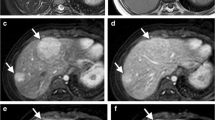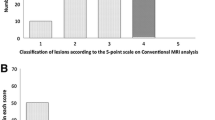Abstract
Background: We compared nonenhanced and dynamic gadolinium (Gd)–enhanced magnetic resonance imaging (MRI) appearances of hepatic focal nodular hyperplasia (FNH) as depicted with breath-hold MR sequences and assessed the detectability of the individual MR sequences used. Methods: We retrospectively reviewed 48 consecutive patients with FNH. All patients underwent nonenhanced (T1 fast low-angle shot [FLASH] and T2 half-Fourier acquisition [HASTE]) and dynamic Gd-enhanced (T1 FLASH) MRI between December 1997 and March 2000. Individual MR sequences were analyzed separately for number of lesions, signal intensity features, dynamic enhancement pattern, and the presence and enhancement profile of a central scar. Ninety-five percent confidence intervals of absolute discrepancy were calculated to define differences in lesion detection. Results: Seventy-seven lesions were found in 48 patients. Nonenhanced FLASH imaging depicted 59 (76.6%) lesions in 45 patients. HASTE images showed 55 (71.4%) lesions in 44 patients. On T1- and T2-weighted images, lesions appeared predominantly hypointense (69.5%) and hyperintense (72.7%), respectively. Arterial and portal venous dominant phase Gd-enhanced MRI demonstrated all 77 lesions (100%), most of which showed hypervascular (94.8%), homogeneous (97.4%), and incomplete (except the central scar: 58.4%) enhancement in the arterial phase. Portal venous phase images showed lesion isointensity (50.6%) or moderate hyperintensity (46.8%) with complete enhancement (central scar: 94.8%). A central scar was detected on nonenhanced T1-weighted images (hypointense: 100%), T2-weighted images (hyperintense: 100%), arterial phase (hypointense: 59.7%) and portal venous phase (hyperintense: 71.4%) Gd-enhanced images in 78%, 69.1%, 77.9%, and 75.3% of tumors, respectively. Conclusion: Arterial and portal venous phase Gd-enhanced T1-weighted sequences are superior to nonenhanced images in the detection of FNH. Typical MRI appearances include hypointensity on T1-weighted and hyperintensity on nonenhanced T2-weighted images. Most commonly, FNH shows a homogeneous (without scar) and strong enhancement during the arterial phase, with lesion isointensity or slight hyperintensity during the portal venous phase.
Similar content being viewed by others
Author information
Authors and Affiliations
Additional information
Received: 15 May 2001/Revision accepted: 22 August 2001
Rights and permissions
About this article
Cite this article
Mortelé, K., Praet, M., Van Vlierberghe, H. et al. Focal nodular hyperplasia of the liver: detection and characterization with plain and dynamic-enhanced MRI. Abdom Imaging 27, 700–707 (2002). https://doi.org/10.1007/s00261-001-0140-6
Issue Date:
DOI: https://doi.org/10.1007/s00261-001-0140-6




